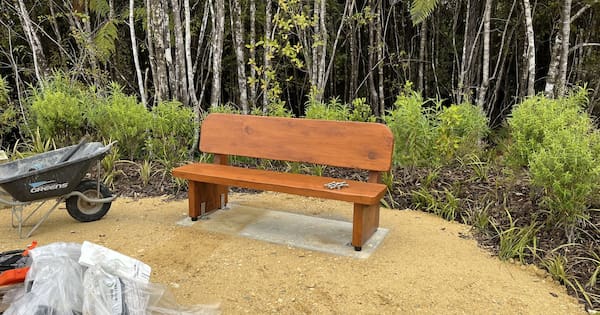
As a local lad, he grew up nearby and hunted on the property. Six years ago, Mr Cairns and his family moved back to Owaka where his wife is deputy principal at Catlins Area School and their two young sons attend school.
They live on the family sheep and beef farm and he is a full-time manager for Southern Forests and has been overseeing the Wisp development.
Ingka Investments bought the 5500ha Wisp Hill in 2021 and undertook 330ha of planting radiata pines that year. Having an existing relationship with the property’s previous owners made the transition out of farming and into forestry easier, he said.
Between 500ha and 1000ha have been planted every year since to now total about 3300ha planted. The most fertile land has been subdivided and sold.
It was a long-term afforestation project with a 30-year rotation. Most of the forest was radiata pine, but up to 20% had been reserved for longer-rotation species such as redwood, beech, totara and rewarewa.
Also set aside was 25% for close-to-nature native plantings and 15% for permanent biodiversity conservation.
Mr Cairns acknowledged Ingka’s first purchase in New Zealand was a fairly high-profile acquisition which attracted its critics.
He is a straight talker, who says there is ‘‘nothing to hide’’ on the Wisp, and he comes with a perspective honed from a background of both farming and forestry.
‘‘I personally never had a problem with it. To be honest, it’s not the greatest farming country in the back here. It’s cold, miserable and wet,’’ he said, during a drive around the property.
There would always be a few diehard sheep and beef farmers who would be against forestry and it was unlikely they would ever change their mind. But generally, the local community had been ‘‘pretty good’’ about it, he said.
The biggest hurdle had been getting particularly locals to understand that it was not a carbon forest. And despite multiple fundraising 4WD trips and horse treks through the Wisp, even lately there were still people believing it was all about carbon.
Rather, it was a huge amount of investment in planting good tree genetics and then managing the plantings for timber, he said.
Mr Cairns was frustrated those who voiced their opinions about the forestry industry often did not seem to understand the size of that industry and its contribution to the economy.
And he was also pushing the message of how the Wisp Hill development benefited his own local community through employment of locals —from the local helicopter pilot and agricultural contractors to the seasonal staff, some of whom had been managed to keep on fulltime.
There were no fewer people living on the property now than when it was a sheep and beef farm: there were actually more, he said.
The property had relatively poor access infrastructure and there had been a focus on upgrading farm tracks to provide all-year access.
A lot of country was solid bracken fern and gorse which was cleared with a bulldozer or digger. Anything too steep was burned. The Wisp was bad for gorse and about 350ha and 400ha of gorse had been physically cleared.
The property had only been planted to about 420m above sea level. On the higher country, it was Pinus attenuata which was resilient in snow and high winds with similar timber qualities to radiata.
Growth rates in the area were some of the highest in the country for radiata with the rain falling at the right time of year, Mr Cairns said.
The country was a ‘‘perfect’’ habitat for pests and under Ingka’s stewardship, there had been 530 wild pigs, 1600 red deer, 4000 possums, 300 rabbits and 3000 hares removed from the property.
Deer and possums were the biggest issue when it came to establishing trees and one area had been replanted several times because of the damage caused by deer.
Two pest workers were on the property between two and four nights a week doing pest control year-round until the trees were established and then it would be a matter of keeping them to a manageable level.
A permit system was used for recreational hunters at weekends which worked well and neighbours also contacted Mr Cairns if they had any issues. Ingka had funded materials to upgrade a boundary fence with hot wires for pig control.
Fur from the possums and meat from the likes of the deer and hares was sold.
An ecological survey was undertaken on the property and monitoring was ongoing. The Wisp Range was a semi-alpine range and contained plants that, at the highest of altitudes, were virtually only found elsewhere in the Southern Alps, he said.
The Catlins River ran through the middle of the property and there were set-back measures to protect water quality and there was ongoing water monitoring. Manuka had been planted alongside waterways and Mr Cairns had also been working with the Catlins Water Catchment Group.
While there was a minimum of 10m on waterways, many had set-backs of 30m, 40m or 50m, so there were never any issues of felling trees near waterways. Several ponds had been built for monsoon bucket-dipping in the event of a fire.
Ingka had also upgraded access to the start of the Thisbe Valley Track, which provides access to the Maclennan Range and was popular with hunters and trampers, and had planted the likes of totara, mountain beech, red beech, white pine and pittosporum in the area.














